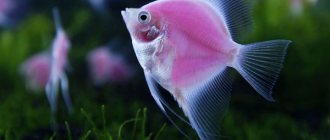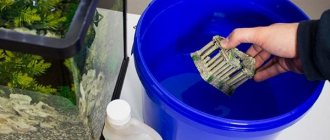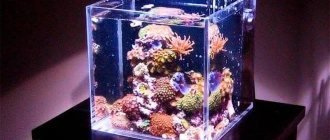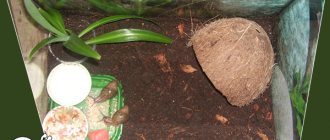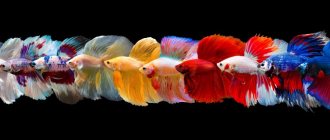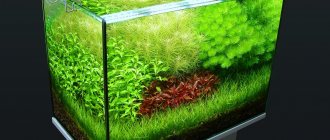An aquarium may seem like a real luxury - especially if we are talking about a large tank with huge exotic fish, turtles and other unusual inhabitants. Unfortunately, not everyone can afford such an artificial pond due to lack of space, funds or experience. However, aquarium lovers have a solution - a small aquarium, a mini-world with small inhabitants, who are sometimes in no way inferior in beauty to their larger and more extravagant relatives. In addition, modest tanks are gradually becoming fashionable, becoming an excellent decor for both small and spacious spaces. How to set up and with whom to populate a small aquarium?
Fish for a small aquarium
The fish must be unpretentious and hardy, no larger than 6 cm in size. Popular unpretentious species can be found in a separate article. For populating small aquarium fish, the following rule is relevant: for a 5-centimeter individual, 3–5 liters of water are required, so for an aquarium of 5–15 liters the following are suitable:
- guppy;
- micro-assessments;
- cockerels;
- zebrafish;
- aquarium snails;
- cherry, crystal or amano shrimp.
In a larger tank you can place:
- catfish corridors;
- small barbs;
- tetra;
- neon;
- Laliusov.
Aquarium with one fish
A betta is ideal for single keeping in a 5-liter or 10-liter tank. To keep the color intense, you can place a mirror next to the glass, then the betta will mistake the reflection for another male. Single keeping of swordtails and mollies is also acceptable.
Filters
For small tanks this device is vital. With its help, it is possible to maintain the fragile balance of the mini-ecosystem, eliminating even minor fluctuations that could seriously harm its inhabitants. Therefore, a pump without a sponge or with a small sponge will save the situation.
It is advisable to use such devices only if there are no fish in the tank, it is abundantly planted with living vegetation, and only invertebrates live. In this case, you can not install a filter at all or install only a compressor. If the tank is inhabited by fish, regular filtration of the aquatic environment is necessary:
- the device must pass at least eight volumes of water within an hour;
- do not create intense water currents that can damage vegetation, fish and crustaceans.
It is important to consider that small animals can enter the water intake, and this is recommended to be avoided. We also must not forget about the aesthetic side of the matter - the device should look good against the background of the overall landscape. It is easiest to maintain a device with a removable filter material; it is removed without first installing the entire device and washed.
When choosing a suitable device, you can consider the following designs as options:
- Internal cleaner with open sponges . This is a device without a housing, which means that small inhabitants will not be drawn into it. A large sponge, which is recommended to be replaced with a material with small pores, does an excellent job of mechanically cleaning the tank and acts as a habitat for the breeding of bacterial microorganisms. Some models of this type are placed with the sponge facing up, which allows you to quickly and easily remove it if necessary.
- External mounted filtration in the form of a waterfall . Compact device - its main part is located on the outside of the tank. Quite voluminous, so you can put various filter components in it. The disadvantage of the external hinged structure is the impossibility of installing a lid on the tank. To prevent aquarium inhabitants from being drawn into the filter, it is recommended to block the opening of the water intake tube with a fine mesh or place a sponge in it.
- External canister filter . Today you can find similar devices on sale that are suitable for small containers. Provide excellent filtration and do not take up much space. As with the previous type, it is worth covering the water intake tube with a sponge or mesh. The only downside of the device is its fairly high price.
In addition, there is always the opportunity to get acquainted with the work of experienced aquarists who build suitable structures with their own hands. Some of them, while observing all the features - the needs of fish, plants, the size of the container, perform their functions perfectly, no worse than industrial devices.
Vegetation acts as an additional filter. Sometimes plants are placed in a hanging waterfall, thus constructing a phytofilter.
Settlement rules
Some fish do well alone in a small aquarium, while others require schooling, so they are kept in large tanks. The minimum number of pets for one flock is 6 pieces. If a schooling individual is kept alone, it will become depressed, its color will fade, and its lifespan will be shortened. Some small schooling fish show aggression in the absence of a group of relatives in the aquarium. Also keep in mind that the inhabitants of a small aquarium inhabit different layers: the upper and middle ones are inhabited by mobile species, and the lower level serves as a home for catfish.
Suitable inhabitants for a nano aquarium
When the reservoir is ready, all that remains is to decide who will inhabit it? Of course, the inhabitants of a 10-20 liter tank should be of modest size; 2-6 cm fish do well in such a modest space. However, even such little ones need space to move freely.
Who definitely should not be placed in a mini-tank are fish with increased aggression and territoriality. Active and fussy medium-sized barbs, swordtails, cichlids, gouramis and zebrafish will also be uncomfortable in an aquarium whose volume does not exceed 10 liters. In addition, these inhabitants need a large number of reliable shelters.
The following fish can live well in a 10-20 liter tank:
- small barbs;
- Gertrude's pseudo-mugili;
- orysias;
- cherry barbs;
- rasboras;
- firefly tetras;
- neons;
- Amanda tetras;
- catfishes otocinclus and corydoras.
You can add amano or cherry shrimp, fish of the poeciliid genus, or small livebearers into a common modest aquarium.
It is important to select fish that have strong immunity, that is, not highly purebred, but hybrid species. If the volume of the container does not exceed 8-10 liters, you can put a Siamese cockerel in it - it feels great alone and, due to its pugnacious disposition, does not get along well with its fellows.
Plants
Choose slow-growing plants. If there is good lighting, specialized soil containing organic matter, and a carbon dioxide supply system, plant in the soil:
- marsilia;
- Japanese blixa;
- bacopa;
- pennywort;
- Hemianthus cube plant.
If the lamp is built into the lid of a small aquarium, the lighting may not be sufficient for some plants. Also make sure that the water parameters are suitable for aquarium greens. In low to moderate light the following survive:
- mosses (key moss, Java moss, nano-moss);
- cryptocorynes (Willis, parva, Beckett);
- anubias (dwarf, golden, bonsai);
- ferns (orange, narrow-leaved, Thai);
- Cladophora globular.
Scenery
The scenery serves as shelter for the animals. It is important that decorations occupy up to 50% of the height and no more than 25% of the bottom area. Aquarium decorations should not contain any hazardous substances and should have no sharp corners so that small fish cannot get hurt. Wash your decorations before diving. Good fit:
- stones;
- caves;
- wood driftwood;
- pots;
- homemade shelters from coconut shells.
A snag protruding from the water looks natural, but if you have shrimp or crayfish, the animals can escape along it.
Equipment
You can't do without a filter and a compressor. Only fastidious plants need a carbon dioxide supply system. A heater is also optional.
Lighting
Lighting can be arranged above the surface of the water using fluorescent or LED lamps. It is important to keep fish that are not prone to jumping out of the water. Choose lamps with white light to prevent algae from fouling the glass. Remember that yellow and green light bulbs stimulate algae growth. Place the small tank away from sunlight.
View this post on Instagram
Posted by Aquascaper (@aquascaperorg) Jan 10, 2021 at 3:53 am PST
Filter
For a small aquarium, an internal filter or an external one with a tube is suitable. Check that the filter material can be easily removed for washing. In an hour, the filter should distill a volume of water equal to 8–15 volumes of the aquarium, without creating a powerful pressure. In a small volume, you can entrust aeration to a filter, but it is better if there are two different devices. Plants act as an additional source of oxygen. A suitable filter should be small and unobtrusive.
Water heater
A heater in a small aquarium is necessary if the room temperature is too low for a particular type of pet. Monitor temperature fluctuations by installing a thermometer.
Which tank is considered small?
Among such tanks, containers with a volume of less than 40 liters are considered small. Most often we are talking about 5-20 liter aquariums. They are often called nanoaquariums - from the Greek. “small”, which emphasizes not only their size, but also a modern, quite technological appearance.
You can also find 1-2 liter microaquariums on sale, which remain empty or are populated with snails. The author of the smallest tank is miniaturist Anatoly Kononenko, who, with the participation of his son Stanislav, placed soil material, a microscopic compressor, tiny bushes and fry into a 10-ml container.
It’s worth noting right away that a three-liter jar with a flock of guppies or one imposing goldfish cannot be called a nanoaquarium. Any aquarist will confirm that keeping fish in such harsh conditions is highly not recommended.
Regardless of the size of the tank, it must be a complete, biological system, equipped for a comfortable life for its inhabitants. To equip a small aquarium in this way, you need to have some experience and knowledge.
But if it is possible to create such a microcosm, it usually becomes the real pride of the owner, amazing and impressive. Regardless of the population and design of the tank, it should please the eyes of others and be comfortable for the inhabitants themselves.
Decor
You can also decorate mini aquariums tastefully. Styles suitable even for 10 liter containers:
- Iwagumi is a Japanese style that uses several stones of different sizes covered with moss. There must be an odd number of stones. In the center of the composition is the largest cobblestone, the second largest is next to the central one. Smaller stones should emphasize the composition, and the smallest ones should remain unnoticeable.
- Ryoboku - decoration using driftwood. Green plants are placed on the branching frame.
- Wabi-kusa - a hill of moss is created in the aquarium, the design is complemented by small driftwood and bushes.
- Taiwanese. A feature of the style is the imitation of squares and parks. Paths are laid out among the vegetation, benches and figurines are placed.
Starting an aquarium
Prepare a reservoir for populating aquarium fauna:
- pour soil and arrange decorations;
- fill the tank with water;
- plant plants;
- install and turn on the necessary equipment;
- turn on the lights for 8–10 hours a day;
- after 2–3 days, start stocking the fish;
- on the 7th day after start-up, replace up to a quarter of the water volume.
Maintain a schedule for cleaning and turning lights on and off. If a small aquarium is populated only by top-level fish, feed them small, non-sinking flakes at first. When the balance of beneficial bacteria is established, add other foods to the diet. Use water tests in the first weeks after launch.
How to care for a micro-community
Any aquarium specialist will tell you that equipping a small container is much more difficult than a spacious, voluminous tank. On the contrary, a small aquarium needs more frequent water changes, and it is difficult to maintain stable parameters of the aquatic environment in it, they are too changeable.
If the owner does not make weekly changes, soon the walls begin to become covered with waste products of the inhabitants, and accordingly, manual cleaning becomes a labor-intensive task. In addition, the remains of food that settle on the ground almost immediately begin to spoil the water, disturbing the biological balance.
If the future owner is not afraid of difficulties, and he approaches the issue seriously, it is worth purchasing not only an aquarium, but also additional devices at once: lighting, heating, filtering. There are several important nuances that make maintaining a small aquarium easier:
- It is important that the tank is equipped with a device that maintains a stable water temperature. Otherwise, even a minor change can negatively affect the condition of the fish.
- The inhabitants of a small tank should be fed small portions of food so that there is as little waste as possible. All excess should be removed from the aquarium immediately, without waiting for it to rot.
- Frequent water changes will be required to stabilize the bacteria count in the filter. They are capable of converting toxic substances generated during waste decay into safe compounds.
- It is necessary to constantly settle the water so that it is always ready - a change of 20-25% of the total volume is carried out twice a week.
- It is worth considering that if the aquarium is located close to a source of natural light and sunlight, the vegetation will begin to grow rapidly. To prevent this from happening, it is advisable to place it away from the window.
It is not recommended to expose the tank to direct sunlight, and daylight hours should be gradually increased, from 6 to 10 hours, until the biological balance is stabilized.

